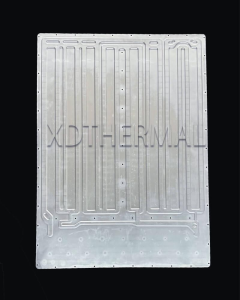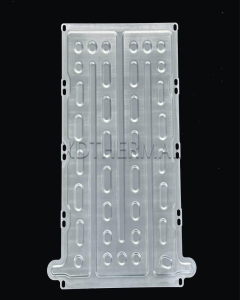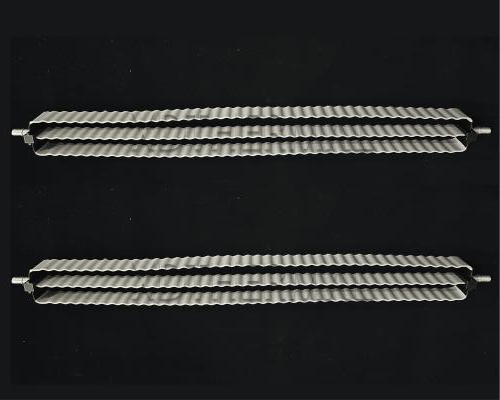As the specific energy of the battery becomes higher and higher, when the battery pack is discharged at a high rate, the air flow rate required for cooling the battery pack is also greater. While huge noise is generated, the power requirements of the fan are also greatly increased, which gradually cannot meet the needs of electric vehicles. At the same time, the air cooling effect in high temperature environments is not ideal, so the power battery pack air cooling heat exchange technology can no longer meet the market demand. Take water as an example. It is known that the thermal conductivity of water at room temperature is dozens of times that of air, and the specific heat capacity of water is 4 times that of air. Therefore, the heat exchange efficiency of liquid is higher than that of air, and it can better meet the temperature control needs of power battery packs.
Fundamental Principles of Liquid Cooling:
In the power battery pack scenario, the liquid medium circulates in the liquid cold plate to take away the heat of the battery core (i.e., the heating element) that is in close contact with the cold plate. The purpose is to reduce the temperature difference when the battery core is running and make it stable. At the appropriate temperature (usually 25°C), the life of the battery core can be extended. This method of liquid cooling is indirect liquid cooling. As shown in the figure, usually the structural frame of a battery pack includes the following
Active liquid Cooling Strategies
Active liquid cooling systems and passive cooling approaches represent contrasting strategies for managing thermal loads in various applications, each with its own set of trade-offs regarding complexity, energy consumption, and thermal performance. Usually active cooling is the main focus in power battery packs, which can be further subdivided into liquid cooling and evaporation cooling.
liquid cooling
It is typically involve additional components such as pumps, hoses, heat exchangers, and control systems. The complexity arises from the need to actively circulate coolant through the system and regulate coolant temperature
and flow rates. Evaporation cooling
The external accessories are simple and usually connected to AC. The biggest difference from liquid cooling is that the internal medium is refrigerant instead of water. The heat exchange efficiency is higher and the integration is stronger.
Liquid cooling at the bottom of the battery


Cold plates, also known as liquid cooling plates, are typically made of materials with high thermal conductivity, such as aluminum or copper. And aluminum is more mainstream. These plates feature embedded cooling channels through which coolant flows, directly contacting the bottom surface of the battery cells. This direct contact enables efficient heat transfer and uniform temperature distribution across the battery pack.
Micro-channel tube liquid cooling plate
Use aluminum extrusion to process the flow channel, and then weld it with the headers at both ends.
Profile + friction stir welding liquid cooling plate
The cold plate flow channel is directly formed using the aluminum extrusion process, and then the circulation is opened through machining.
Use friction welding, etc. to seal flow channels and pipes.
Punched liquid cooling plate
Principle: Rely on the press and mold to stamp the aluminum material to cause plastic deformation to form a flow channel, and the upper and lower shells are welded together through needle welding.
Plate-fin liquid cooling plate
Fill the upper and lower thermal conductive panels with zigzag heat exchange fins, and then pass them through a flux-free vacuum
Brazing technology achieves cold plate sealing. Buried tube liquid cooling plate
Shallow buried tube process liquid cooling plate: the copper tube is flattened and milled at the same time as the aluminum plate.
It is fully conducive to the high thermal conductivity of copper tubes to take away heat, and the lightweight aluminum is used to reduce weight and control costs. Suitable for single-sided installation of components.
Machin plus welding machine type liquid cooling plate
The flow channel is machined and then sealed with the upper cover through friction stir welding.
Integrated liquid cooling box(insert link: https://www.xdthermal.com/ev-battery-enclosures.html/)
The box is manufactured by die-casting process, supplemented by friction stir welding, machining and other processes; the size is generally small, and the tailor-welding process can be used to process larger boxes; impurities and pores during the die-casting process need to be controlled; When the sealing requirement is IP67, the sealing surface should be machined and milled and sealed with a sealing strip.
Liquid Cooling on Battery Side

Advantages of Bottom Liquid Cooling
Uniform Temperature Distribution: Bottom surface heat exchange helps maintain uniform temperatures across the battery pack, reducing the risk of hotspots and thermal gradients that can degrade battery performance and lifespan
Space Efficiency: Integrating cooling channels into the bottom surface of the battery pack maximizes space utilization and minimizes the overall footprint of the thermal management system
Flexibility in System Design:
Side heat exchange systems offer flexibility in system design and integration, allowing for customization to suit specific application requirements. This versatility enables engineers to optimize cooling performance while accommodating varying heat sources, space constraints, and thermal management objectives.
Compatibility with Hybrid Cooling Systems:
Side heat exchange methods are compatible with hybrid cooling systems, where multiple cooling methods are combined to achieve synergistic thermal management benefits. By integrating side heat exchange components with air cooling or other passive methods, engineers can create hybrid systems tailored to the needs of diverse applications.
Future Prospects and Emerging Trends
- EnhancedThermal Management for High-Power and High-Voltage EVs:
As EV powertrains continue to evolve, with higher power densities and longer driving ranges, the demand for more efficient thermal management solutions increases. Future trends in liquid cooling for EVs involve closer integration with battery pack design to optimize space utilization, weight distribution, and overall vehicle performance. Innovative cooling plate designs and packaging strategies aim to maximize cooling efficiency while minimizing the impact on overall pack size and weight.
- AdvancedMaterials and Fluids:
Research into advanced materials and coolant fluids holds promise for further enhancing the thermal conductivity and heat transfer properties of liquid cooling systems in EVs. Graphene-based heat spreaders, nanofluids, and other advanced materials offer opportunities to improve cooling performance while
reducing system weight and complexity. Strength enhancement is currently at the centre of research in composite materials.
- IntelligentCooling Management Systems:
In addition to the above components of the battery liquid cooling system, the intelligent cooling management system is a major trend for future development, which provides real-time monitoring and adaptive control of coolant flow and temperature. Predictive analytics and machine learning algorithms enable proactive adjustments to cooling parameters based on driving conditions, battery state-of-charge, and ambient temperature, optimizing thermal management efficiency and extending battery life.
- RapidCharging Compatibility:
Liquid cooling systems play a crucial role in enabling rapid charging capabilities in EVs by efficiently dissipating heat generated during fast charging cycles.
Future trends may involve the development of liquid cooling solutions specifically tailored to the requirements of high-power charging infrastructure, ensuring optimal thermal performance and reliability during fast charging sessions.
In conclusion, liquid cooling stands as a cornerstone technology in the realm of power battery pack thermal management. With its ability to efficiently dissipate heat, ensure uniform temperature distribution, and adapt to diverse application needs, liquid cooling emerges as a versatile and effective solution for optimizing the performance and longevity of battery systems.






